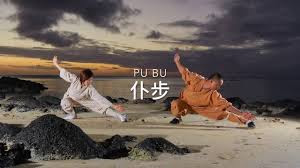Posts
wu bu quan
- Get link
- Other Apps

The first wushu form: Wu Bu Quan The Wu Bu Quan literally means 5 stances. This form is the very first wushu form you should learn. Wushu beginners should practice the 5 stances form every day. Sometimes you should try to hold each stance for 30 seconds (for strength) and sometimes you should try to do it very slowly (for the form). As you can guess from its name, its purpose is improving the 5 basic wushu stances. Here is the list of the stances in the form: 1. Yi bu - First stance 2. Jin ji duli - Golden rooster stand on one leg (it's not on the video, but we do have it in our routine) 3. Pu bu - Flat stance (not on the video) 4. Gong bu - Bow stance 5. Tan tui chong quan - Toe fist kick 6. Ma bu - Horse stance 7. Xie bu - Resting stance 8. Jin ji duli - Golden rooster stand on one leg 9. Pu bu - Flat stance 10. Xu bu - Empty stance
Northern and southern kungfu
- Get link
- Other Apps
Chinese martial arts have a wide range of styles and can be categorized in different ways, such as by religion (like Taoist, Buddhist, or Islamic) or by their major applications (kicking, hitting, wrestling, or grabbing). But one of the biggest dividing lines is geographical; as a country with one of the most diverse climates and topographies, distinctive martial arts styles eventually developed all over the country. Kung Fu is one of the most ancient martial arts on the planet. If you watch a fight between someone trained in a northern style of kung fu versus someone trained in a southern style the difference would be apparent. The Northern fighting style, also known as “Long Fist” style, focuses more on aesthetics, kicks, legwork, and acrobatics. The Chinese in the north are taller on average than the southern Chinese, thanks largely to their grain and meat-heavy diets. Having longer bodies and limbs would eventually lead into developing a fighting style that would exploit thes
History
- Get link
- Other Apps

In 1958, the government established the All-China Wushu Association as an umbrella organization to regulate martial arts training. The Chinese State Commission for Physical Culture and Sports took the lead in creating standardized forms for most of the major arts. During this period, a national Wushu system that included standard forms, teaching curriculum, and instructor grading was established. Wushu was introduced at both the high school and university level. This new system seeks to incorporate common elements from all styles and forms as well as the general ideas associated with Chinese martial arts. Stylistic concepts such as hard, soft, internal, external, as well as classifications based on schools such as Shaolin, Taiji, Wudang and others were all integrated into one system. Wushu became the government sponsored standard for the training in martial arts in China. [5] The push for standardization continued leading to widespread adaptation. In 1979, the State Commission for
- Get link
- Other Apps
Wushu ( / ˌ w uː ˈ ʃ uː / ), or Chinese Kungfu , is a hard and complete martial art, as well as a full-contact sport . [1] [2] It has a long history in reference to Chinese martial arts. It was developed in China after 1949 in an effort to standardize the practice of traditional Chinese martial arts, [3] yet attempts to structure the various decentralized martial arts traditions date back earlier, when the Central Guoshu Institute was established at Nanking in 1928. " Wushu " is the Chinese term for "martial arts" (武 "Wu" = military or martial, 術 "Shu" = art). In contemporary times, Wushu has become an international sport through the International Wushu Federation (IWUF), which holds the World Wushu Championships every two years; the first World Championships were held in 1991 in Beijing . [4] The World Kungfu Championships are held every four years subset International Wushu Federation , as well. Competitive Wushu is com